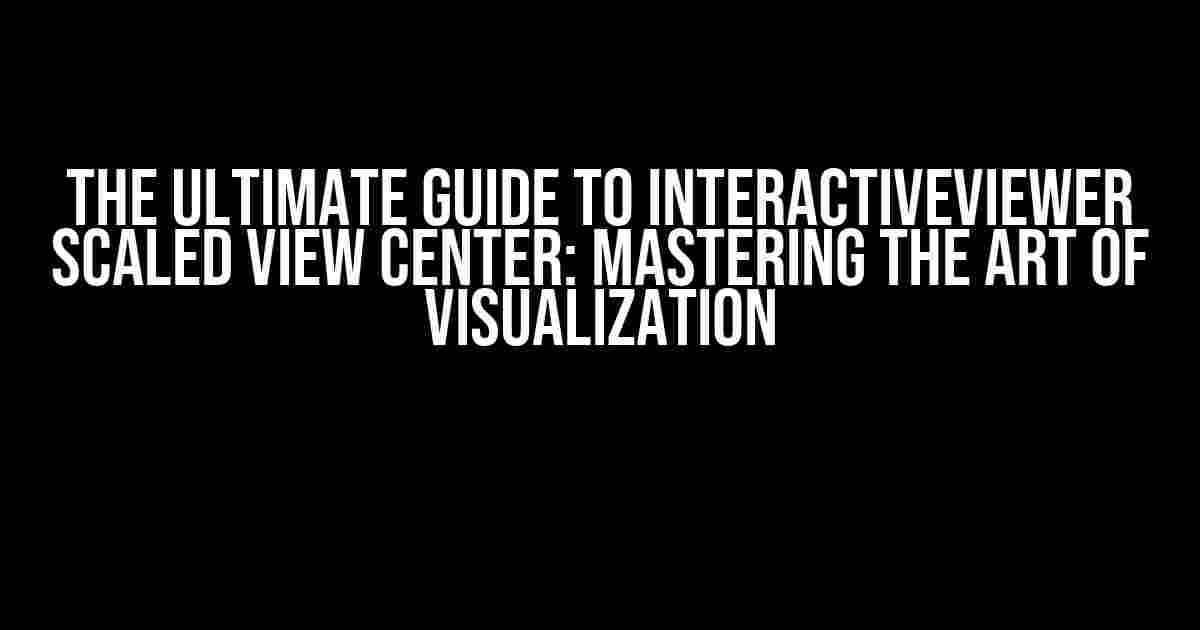Are you tired of struggling to navigate complex visualizations? Do you want to take your data analysis to the next level? Look no further! In this comprehensive guide, we’ll dive into the world of InteractiveViewer scaled view center, a game-changing technology that revolutionizes the way we interact with data. Buckle up, and let’s get started!
What is InteractiveViewer Scaled View Center?
InteractiveViewer scaled view center is a powerful tool that allows users to zoom in and out of visualizations while maintaining a centered view. This innovative feature enables seamless navigation, empowering users to explore complex data sets with ease. By adjusting the scale and center of the view, users can uncover hidden patterns, identify trends, and gain valuable insights.
Benefits of InteractiveViewer Scaled View Center
-
Enhanced Navigation: Navigate complex visualizations with ease, zooming in and out while maintaining a centered view.
-
Improved Data Analysis: Quickly identify trends, patterns, and relationships in your data, leading to more accurate insights.
-
Increased Productivity: Spend less time navigating and more time analyzing, thanks to the intuitive and efficient interface.
Setting Up InteractiveViewer Scaled View Center
To get started with InteractiveViewer scaled view center, follow these step-by-step instructions:
-
Install the InteractiveViewer Library: Download and install the InteractiveViewer library, available for both desktop and mobile devices.
-
Import the Library: Import the InteractiveViewer library into your project, using the following code:
import InteractiveViewer from 'interactive-viewer'; -
Create a New Instance: Create a new instance of the InteractiveViewer, passing in your data and configuration options:
const viewer = new InteractiveViewer({ data: myData, scale: 1, center: [0, 0], }); -
Configure the Scaled View Center: Set the scaled view center options, including the initial scale and center coordinates:
viewer.setScaledViewCenter({ scale: 2, center: [100, 100], });
Customizing InteractiveViewer Scaled View Center
Take your visualization to the next level by customizing the InteractiveViewer scaled view center:
Scale Options
Adjust the scale of the visualization using the following options:
| Option | Description |
|---|---|
| scale | Sets the initial scale of the visualization. |
| minScale | Sets the minimum scale limit. |
| maxScale | Sets the maximum scale limit. |
Center Options
Configure the center coordinates of the visualization using the following options:
| Option | Description |
|---|---|
| center | Sets the initial center coordinates. |
| minCenter | Sets the minimum center coordinates. |
| maxCenter | Sets the maximum center coordinates. |
Tips and Tricks for Mastering InteractiveViewer Scaled View Center
Take your InteractiveViewer skills to the next level with these expert tips and tricks:
-
Use Gestures: Use intuitive gestures to zoom in and out, and pan across the visualization.
-
Customize the UI: Tailor the user interface to your needs, adjusting colors, fonts, and layout.
-
Integrate with Other Libraries: Combine InteractiveViewer with other libraries to create a comprehensive data analysis workflow.
Common Issues and Solutions
Troubleshooting issues with InteractiveViewer scaled view center? Check out these common solutions:
-
Issue: Scaled View Center Not Working
Solution: Check the scale and center options, ensuring they are correctly configured.
-
Issue: Visualization Not Rendering
Solution: Verify that the data is correctly formatted and loaded into the InteractiveViewer instance.
Conclusion
In conclusion, InteractiveViewer scaled view center is a powerful tool that revolutionizes the way we interact with data. By mastering this technology, you’ll unlock new insights, boost productivity, and take your data analysis to the next level. Remember to customize, experiment, and troubleshoot – and most importantly, have fun exploring the infinite possibilities of InteractiveViewer scaled view center!
Stay tuned for more tutorials, guides, and expert insights on InteractiveViewer and data visualization. Happy exploring!
InteractiveViewer Scaled View Center: Unlocking New Possibilities in Data Visualization
Frequently Asked Question
Get ready to zoom in on the answers to your most pressing questions about the InteractiveViewer scaled view center!
What is the scaled view center in InteractiveViewer?
The scaled view center in InteractiveViewer is the point that remains stationary when the view is zoomed or scaled. It’s the anchor point that ensures the view remains focused on the area of interest, even as the user zooms in or out.
Why is it important to set the scaled view center in InteractiveViewer?
Setting the scaled view center is crucial because it determines the point of interest in the view. By setting it correctly, you can ensure that the user’s attention is drawn to the most important part of the visual representation, making it easier for them to understand and interact with the content.
Can I change the scaled view center dynamically in InteractiveViewer?
Yes, you can! InteractiveViewer allows you to change the scaled view center dynamically in response to user interactions or changes in the data. This flexibility enables you to create a more engaging and interactive experience for the user.
How does the scaled view center affect the overall user experience in InteractiveViewer?
The scaled view center has a significant impact on the overall user experience in InteractiveViewer. By setting it correctly, you can reduce cognitive load, improve navigation, and increase user engagement. A well-set scaled view center can make the difference between a confusing and a captivating experience!
Are there any best practices for setting the scaled view center in InteractiveViewer?
Yes, there are! Some best practices include setting the scaled view center based on the data’s natural focal point, considering the user’s task and goals, and testing different settings to ensure optimal user experience. By following these best practices, you can create an engaging and effective interactive visualization.


